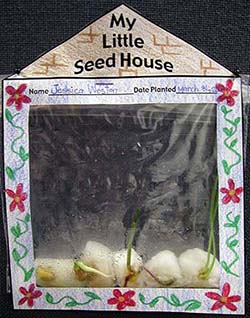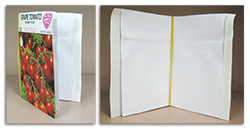My Little Seed House and Seed Book
Students observe the growth and development of seeds and explore what conditions are necessary for seeds to germinate.
Background
Lesson Activities
Recommended Companion Resources
Credits
Author
Vanae Morris, Lynn Wallin | Utah Agriculture in the Classroom
Acknowledgements
Activity 1 adapted from USOE Teacher's Resource Book.
Standards
Texas Content Area Standards
-
ELA: K.110.2.b.1
Developing and sustaining foundational language skills: listening, speaking, discussion, and thinking - - oral language. The student develops oral language through listening, speaking, and discussion.
- ELA: K.110.2.b.1.C: share information and ideas by speaking audibly and clearly using the conventions of language
- ELA: K.110.2.b.1.D: work collaboratively with others by following agreed-upon rules for discussion, including taking turns;
-
ELA: 1.110.3.b.1
Developing and sustaining foundational language skills: listening, speaking, discussion, and thinking - - oral language. The student develops oral language through listening, speaking, and discussion.
- ELA: 1.110.3.b.1.C: share information and ideas about the topic under discussion, speaking clearly at an appropriate pace and using the conventions of language
- ELA: 1.110.3.b.1.D: work collaboratively with others by following agreed-upon rules for discussion, including listening to others, speaking when recognized, and making appropriate contributions
-
ELA: 2.110.4.b.1
Developing and sustaining foundational language skills: listening, speaking, discussion, and thinking -- oral language. The student develops oral language through listening, speaking, and discussion.
- ELA: 2.110.4.b.1.C: share information and ideas that focus on the topic under discussion, speaking clearly at an appropriate pace and using the conventions of language
- ELA: 2.110.4.b.1.D: work collaboratively with others by following agreed-upon rules for discussion, including listening to others, speaking when recognized, making appropriate contributions, and building on the ideas of others
-
Social Studies: 2.113.13.c.16
Social studies skills. The student communicates in written, oral, and visual forms. The student is expected to:
- Social Studies: 2.113.13.c.16.E: communicate information visually, orally, or in writing based on knowledge and experiences in social studies
-
Social Studies: K.113.11.c.14
Social studies skills. The student communicates in oral and visual forms. The student is expected to:
- Social Studies: K.113.11.c.14.C: communicate information visually, orally, or in writing based on knowledge and experiences in social studies
-
Social Studies: 1.113.12.c.17
Social studies skills. The student communicates in oral, visual, and written forms. The student is expected to:
- Social Studies: 1.113.12.c.17.C: communicate information visually, orally, or in writing based on knowledge and experiences in social studies
-
Science: 2.112.4.b.1
Scientific and engineering practices. The student asks questions, identifies problems, and plans and safely conducts classroom, laboratory, and field investigations to answer questions, explain phenomena, or design solutions using appropriate tools and models. The student is expected to:
- Science: 2.112.4.b.1.A: ask questions and define problems based on observations or information from text, phenomena, models, or investigations
- Science: 2.112.4.b.1.B: use scientific practices to plan and conduct simple descriptive investigations and use engineering practices to design solutions to problems
- Science: 2.112.4.b.1.E: collect observations and measurements as evidence
- Science: 2.112.4.b.1.F: record and organize data using pictures, numbers, words, symbols, and simple graphs
- Science: 2.112.4.b.1.G: develop and use models to represent phenomena, objects, and processes or design a prototype for a solution to a problem
-
Science: K.112.2.b.1
Scientific and engineering practices. The student asks questions, identifies problems, and plans and safely conducts classroom, laboratory, and field investigations to answer questions, explain phenomena, or design solutions using appropriate tools and models. The student is expected to:
- Science: K.112.2.b.1.A: ask questions and define problems based on observations or information from text, phenomena, models, or investigations.
- Science: K.112.2.b.1.B: use scientific practices to plan and conduct simple descriptive investigations and use engineering practices to design solutions to problems.
- Science: K.112.2.b.1.E: collect observations and measurements as evidence.
- Science: K.112.2.b.1.F: record and organize data using pictures, numbers, words, symbols, and simple graphs.
- Science: K.112.2.b.1.G: develop and use models to represent phenomena, objects, and processes or design a prototype for a solution to a problem.
-
Science: K.112.2.b.2
Scientific and engineering practices. The student analyzes and interprets data to derive meaning, identify features and patterns, and discover relationships or correlations to develop evidence-based arguments or evaluate designs. The student is expected to:
- Science: K.112.2.b.2.A: identify basic advantages and limitations of models such as their size, properties, and materials.
- Science: K.112.2.b.2.B: analyze data by identifying significant features and patterns.
- Science: K.112.2.b.2.C: use mathematical concepts to compare two objects with common attributes.
- Science: K.112.2.b.2.D: evaluate a design or object using criteria to determine if it works as intended.
-
Science: K.112.2.b.3
Scientific and engineering practices. The student develops evidence-based explanations and communicates findings, conclusions, and proposed solutions. The student is expected to:
- Science: K.112.2.b.3.A: develop explanations and propose solutions supported by data and models.
- Science: K.112.2.b.3.B: communicate explanations and solutions individually and collaboratively in a variety of settings and formats.
- Science: K.112.2.b.3.C: listen actively to others' explanations to identify important evidence and engage respectfully in scientific discussion.
-
Science: K.112.2.b.4
Scientific and engineering practices. The student knows the contributions of scientists and recognizes the importance of scientific research and innovation on society. The student is expected to:
- Science: K.112.2.b.4.A: explain how science or an innovation can help others.
-
Science: K.112.2.b.5
Recurring themes and concepts. The student uses recurring themes and concepts to make connections across disciplines. The student is expected to:
- Science: K.112.2.b.5.A: identify and use patterns to describe phenomena or design solutions.
- Science: K.112.2.b.5.G: describe how factors or conditions can cause objects, organisms, and systems to either change or stay the same.
-
Science: K.112.2.b.12
Organisms and environments. The student knows that plants and animals depend on the environment to meet their basic needs for survival. The student is expected to:
- Science: K.112.2.b.12.A: observe and identify the dependence of plants on air, sunlight, water, nutrients in the soil, and space to grow.
-
Science: K.112.2.b.13
Organisms and environments. The student knows that organisms resemble their parents and have structures and undergo processes that help them interact and survive within their environments. The student is expected to:
- Science: K.112.2.b.13.A: identify the structures of plants, including roots, stems, leaves, flowers, and fruits.
- Science: K.112.2.b.13.C: identify and record the changes from seed, seedling, plant, flower, and fruit in a simple plant life cycle.
-
Science: 1.112.3.b.1
Scientific and engineering practices. The student asks questions, identifies problems, and plans and safely conducts classroom, laboratory, and field investigations to answer questions, explain phenomena, or design solutions using appropriate tools and models. The student is expected to:
- Science: 1.112.3.b.1.A: ask questions and define problems based on observations or information from text, phenomena, models, or investigations.
- Science: 1.112.3.b.1.B: use scientific practices to plan and conduct simple descriptive investigations and use engineering practices to design solutions to problems.
- Science: 1.112.3.b.1.E: collect observations and measurements as evidence.
- Science: 1.112.3.b.1.F: record and organize data using pictures, numbers, words, symbols, and simple graphs.
- Science: 1.112.3.b.1.G: develop and use models to represent phenomena, objects, and processes or design a prototype for a solution to a problem.
-
Science: 1.112.3.b.2
Scientific and engineering practices. The student analyzes and interprets data to derive meaning, identify features and patterns, and discover relationships or correlations to develop evidence-based arguments or evaluate designs. The student is expected to:
- Science: 1.112.3.b.2.A: identify basic advantages and limitations of models such as their size, properties, and materials.
- Science: 1.112.3.b.2.B: analyze data by identifying significant features and patterns.
- Science: 1.112.3.b.2.C: use mathematical concepts to compare two objects with common attributes.
-
Science: 1.112.3.b.3
Scientific and engineering practices. The student develops evidence-based explanations and communicates findings, conclusions, and proposed solutions. The student is expected to:
- Science: 1.112.3.b.3.A: develop explanations and propose solutions supported by data and models.
- Science: 1.112.3.b.3.B: communicate explanations and solutions individually and collaboratively in a variety of settings and formats.
- Science: 1.112.3.b.3.C: listen actively to others' explanations to identify important evidence and engage respectfully in scientific discussion.
-
Science: 1.112.3.b.4
Scientific and engineering practices. The student knows the contributions of scientists and recognizes the importance of scientific research and innovation for society. The student is expected to:
- Science: 1.112.3.b.4.A: explain how science or an innovation can help others.
-
Science: 1.112.3.b.5
Recurring themes and concepts. The student uses recurring themes and concepts to make connections across disciplines. The student is expected to:
- Science: 1.112.3.b.5.A: identify and use patterns to describe phenomena or design solutions.
- Science: 1.112.3.b.5.G: describe how factors or conditions can cause objects, organisms, and systems to either change or stay the same.
-
Science: 1.112.3.b.12
Organisms and environments. The student knows that the environment is composed of relationships between living organisms and nonliving components. The student is expected to:
- Science: 1.112.3.b.12.A: classify living and nonliving things based upon whether they have basic needs and produce young.
-
Science: 2.112.4.b.2
Scientific and engineering practices. The student analyzes and interprets data to derive meaning, identify features and patterns, and discover relationships or correlations to develop evidence-based arguments or evaluate designs. The student is expected to:
- Science: 2.112.4.b.2.A: identify basic advantages and limitations of models such as their size, properties, and materials
- Science: 2.112.4.b.2.B: analyze data by identifying significant features and patterns
-
Science: 2.112.4.b.3
Scientific and engineering practices. The student develops evidence-based explanations and communicates findings, conclusions, and proposed solutions. The student is expected to:
- Science: 2.112.4.b.3.A: develop explanations and propose solutions supported by data and models
- Science: 2.112.4.b.3.B: communicate explanations and solutions individually and collaboratively in a variety of settings and formats
- Science: 2.112.4.b.3.C: listen actively to others' explanations to identify important evidence and engage respectfully in scientific discussion
-
Science: 2.112.4.b.4
Scientific and engineering practices. The student knows the contributions of scientists and recognizes the importance of scientific research and innovation for society. The student is expected to:
- Science: 2.112.4.b.4.A: explain how science or an innovation can help others
-
Science: 2.112.4.b.5
Recurring themes and concepts. The student uses recurring themes and concepts to make connections across disciplines. The student is expected to:
- Science: 2.112.4.b.5.A: identify and use patterns to describe phenomena or design solutions
- Science: 2.112.4.b.5.G: describe how factors or conditions can cause objects, organisms, and systems to either change or stay the same
-
Science: 2.112.4.b.11
Earth and space. The student knows that earth materials and products made from these materials are important to everyday life. The student is expected to:
- Science: 2.112.4.b.11.B: describe how human impact can be limited by making choices to conserve and properly dispose of materials such as reducing use of, reusing, or recycling paper, plastic, and metal

